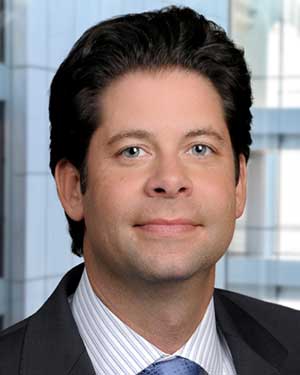The COVID-19 pandemic has not only supported the continued rise of e-commerce and demographic shifts in the multifamily sector, but significantly accelerated those trends. Investors with significant holdings in the commercial real estate sector have taken notice.
For example, PGIM Real Estate recently announced its latest acquisition of a 4.7-million-sq.-ft., 15-building industrial portfolio from Crow Holdings located across Atlanta, Dallas, Fort Worth, Texas and Phoenix for a total value of $425 million. In addition to investments in the industrial sector, the company also sees opportunities for acquisitions of multifamily, storage and data center properties.
NREI spoke with Todd Goldberg, managing director at PGIM Real Estate, to discuss how the pandemic has changed the firm’s investment strategy and what to expect from the investment market going forward.
This Q&A has been edited for style, length and clarity.
NREI: How has your investment strategy changed due to the pandemic?
 Todd Goldberg: PGIM Real Estate invests in real estate globally through a range of equity and debt strategies that span the risk-return spectrum. On the equity side of our U.S. business, this includes everything from core to value-add investment vehicles and can include acquisitions, speculative development, and repositioning projects.
Todd Goldberg: PGIM Real Estate invests in real estate globally through a range of equity and debt strategies that span the risk-return spectrum. On the equity side of our U.S. business, this includes everything from core to value-add investment vehicles and can include acquisitions, speculative development, and repositioning projects.
While our investment strategy overall has become more cautious due to the economic uncertainty driven by COVID-19, there are certain areas of investment where we believe that the secular trends across property types that had already begun pre-COVID are now being accelerated. This includes the continued growth of e-commerce demand, as well as demographic shifts in how and where people live that are impacting multifamily and other housing sectors. We will continue to invest in properties that benefit from these trends, while of course subjecting all of our investments to disciplined underwriting standards.
NREI: What were PGIM Real Estate’s most desired property types right before the pandemic and why? How have those preferences changes under COVID-19 and for what reasons?
Todd Goldberg: In terms of most desired, I would say that as an organization we really looked at all property types and all major sectors: industrial, multifamily, offices and retail, as well as a number of alternatives including self-storage and data centers. In general, we’ve viewed the market fundamentals as the most favorable in the industrial and multifamily sectors, so we spent a disproportionate share of our focus on those sectors before the pandemic. Those preferences haven't changed [since the pandemic]. We actually have more conviction around them relative to some of the other property sectors that are facing more uncertainty, such as retail, hospitality and—to some extent—office.
NREI: What specifically made the Crow Holdings portfolio attractive in the current market climate?
Todd Goldberg: What we liked about that portfolio was that it presented us with a very rare opportunity to acquire a multiregional, well-located, newly built, high quality number of assets. It was already difficult to compete in the industrial market pre-COVID-19, and even post-COVID, there was still a lot of competition for this particular portfolio because of its quality. The properties have very positive leasing momentum that will provide us with concurrent income and potential upside.
NREI: Are there other deals they are working on right now? In which sectors?
Todd Goldberg: Our immediate pipeline and recently closed transactions continue to substantiate our conviction in both industrial and multifamily. There are some alternative asset classes that we’re looking at—for example, we’re continuing to pursue select deals in senior housing—but multifamily and industrial are the main focuses that we’re pursuing right now.
NREI: Have you been doing any dispositions during this time? Why or why not?
Todd Goldberg: We’ve continued to execute on dispositions throughout the pandemic. While a fair amount was front-ended, we have done several billion dollars’ worth of sales—including some very large transactions—in the last few weeks. But we do think that, similar to the buy side, there are a number of investors that are out there looking for the two main property types we have conviction for, which again are industrial and multifamily. Multifamily has been the largest portion of our dispositions and I think that sector, from a valuation perspective, is really holding up well given the attractive terms and the availability of debt. We also own high quality assets in that sector, which has helped us to close dispositions during this time.
NREI: What have been the biggest challenges about completing acquisitions this year?
Todd Goldberg: Trying to create the right set of underwriting metrics has been a continuous challenge because they’ve had to change so much as the markets did. Right after the lockdowns began, the deep uncertainty felt around the world was reflected in the markets, especially the equity markets and some of the bond markets. All transactions seemed to stop and on a weekly basis, we were adjusting underwriting metrics. We’ve spent a lot of time with our internal teams across all investment strategies gathering real time information, which was made more difficult by the fact that transactions weren’t happening. Underwriting metrics have been and will continue to be a challenge in terms of both inputs and market forecasting as we continue to navigate the economic uncertainty.
NREI: Are there new geographic markets you are exploring as a result of the pandemic?
Todd Goldberg: From an overall geographic perspective, we’re diversified. We’re looking at all the major markets that have been hit a bit harder, including New York and San Francisco, for attractive pricing opportunities. Prior to the pandemic, we were focused on the Sunbelt markets and I think that has since been accelerated. But I wouldn’t necessarily say that because of the pandemic we’ve entered new geographic markets.
NREI: Are there markets you are trying to get out of?
Todd Goldberg: Not at this time. I think some markets will experience uncertainty for longer, including the larger urban cities like New York, DC, Boston or San Francisco, but that’s not a reason for us to exit those markets and we believe they’ll bounce back long term and still will be target markets for us.
NREI: At this point is it fair to say the commercial real estate market is in a downturn? How long do you expect this downturn to last and how severe can it be?
Todd Goldberg: I wouldn’t say that the entire market is in a downturn. I think it’s bifurcated—maybe more so than we’ve ever seen. There is capital that is eager to participate in the industrial and multifamily sectors, as well as certain alternative asset classes including self-storage, data centers, and manufactured housing. Other sectors of real estate—certainly retail and hospitality, as well as office to an extent—are experiencing more uncertainty as to when people return to a normalized reality. How long it lasts exactly, I’m not sure, but I hope that we will get a better sense over the next year.
NREI: What is your outlook on the investment market for the next year and then for the next three years?
Todd Goldberg: The next year will continue to be choppy as we navigate the impacts of the pandemic and the elections. We’re likely to see a muted number of transactions and some volatility in those that do take place, meaning that there may be stress sales over the next year or so. I think the market over the next year is going to be relatively quiet, certainly during the front-end of it. Looking out over the three-year period, the transaction volume will pick up, hopefully the virus will be behind us, the election will be over, and we’ll be back to the office post-pandemic. The amount of available capital willing to invest in real estate is a large sum and I think that, combined with low interest rates for the foreseeable future, makes the three-year outlook extremely positive.





